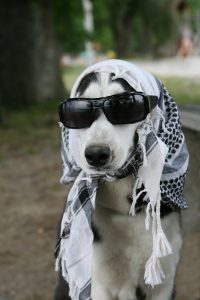 At this time of year one of the questions I’m most frequently asked is, “Does my pet need to wear a coat when she goes outside?”
At this time of year one of the questions I’m most frequently asked is, “Does my pet need to wear a coat when she goes outside?”
Many people assume that since she has a coat of her own – the coat given to her by Mother Nature – Fluffy doesn’t need to wear a coat or sweater. This assumption is erroneous since Fluffy’s own coat has been fooled by modern technology! You see, she’s living in a environmentally controlled climate with the luxury of indoor heating – indoor heating which fools Mother Nature. When animals live outdoors, their coats and their bodies have an opportunity to gradually adjust to the colder temperatures as the summer turns to fall and fall turns to winter. The gradual change of seasons allows the body to acclimate and the coat grows thicker. But when a pet lives indoors with an average temperature of 68 or 70 degrees, her coat just doesn’t grow in the way it needs to offer her full protection. So here’s my rule of thumb – when you go outdoors and you need a coat, so does your pet.
How do you measure your pet for the properly fitting coat or sweater? The best thing to do is to bring your pet with you to the pet shop, if you can. If this is not possible, take a tape measure and measure from her withers (from what we would call the shoulder blades at the base of the neck) and measure down her back to where her tail begins. Write down that measurement. For some broad chested pets, it also helps to measure around the barrel of the chest – measuring around the widest part of the chest. Write down that measurement. And if your pet has a large neck like some of the stockier breeds, be sure to measure around her neck, too. Also note if your pet has a grooming style that has some of its fur puffed up – such as certain poodle clips. Any grooming style that features extra hair may mean that your pet will need one size larger. This also holds true if your pet is a little overweight and has a bit of a tummy (shame on you!).
When buying a coat or sweater, look for good workmanship. Too many pet sweaters and coats are what I consider to be of inferior quality. Pay attention the workmanship around the neck and the tail areas. Are the surfaces smooth? Is the stitching even and uniform so as not to rub against and irritate your pet’s skin? Check what it’s made of and whether it is washable (unless you don’t mind paying your pet’s dry cleaning bills!). Is it waterproof? That’s particularly important if you live in an area subject to lots of snow and rain.
If your pet already has a coat or sweater in the closet, go take a look at it. Does it fit well or did you buy it when Fluffy was younger or several pounds thinner? It may be time for a new one. The same holds true if Fluffy has a tendency towards arthritis. Is it easy for her to get into and out of? If not, get her a style that will be more comfortable and less of a hassle for both of you when it’s time to suit-up.
It goes without saying that senior pets and puppies and kittens need the additional protection coats and sweaters provide. But, as far as I’m concerned, ALL pets that go outdoors should have some winter clothing. Don’t do your pet an injustice this season – be sure she’s well dressed – not just for fashion’s sake, but for the sake of her health.



